Cesare Maffei (born 1805) was an Italian painter of the Neoclassical period, active in Tuscany.

Cesare Maffei (born 1805) was an Italian painter of the Neoclassical period, active in Tuscany.

He was the son of an ornamental painter, and his brother Alessandro, was a decorative painter. Cesare studied at the Accademia di Belle Arti di Siena, under Giuseppe Collignon and Francesco Mazzuoli. Between 1836 and 1838, he helped paint frescoes of angel musicians for the church of San Giacomo, Siena. He also painted a cycle of frescoes for the Palazzo Piccolomini-Clementini.
He was a scenographer and decorator for the Teatro Pagliano in Florence, which would become the Teatro Verdi. In 1854, he decorated the tribune of the church of San Regolo in Montaione, depicting the Virgin in Glory with Saints Regolo and Bartholemew.
In 1855, he completed frescoes for the sacristy of the church of Santa Caterina, Livorno. In 1858, he also painted for the Chapel of Larderel in the church of San Matteo in Livorno. Luigi Ademollo commissioned from Maffei the frescoes for the cupola in Santa Caterina, followed by a collaboration with Pietro Calamai, to paint images of the four evangelists, scenes from the life of the Virgin, and St Dominic receives the Rosary. This work was completed in 1876.

Pinturicchio, or Pintoricchio, also known as Benetto di Biagio or Sordicchio, was an Italian painter during the Renaissance. He acquired his nickname because of his small stature and he used it to sign some of his artworks that were created during the fifteenth and sixteenth centuries.
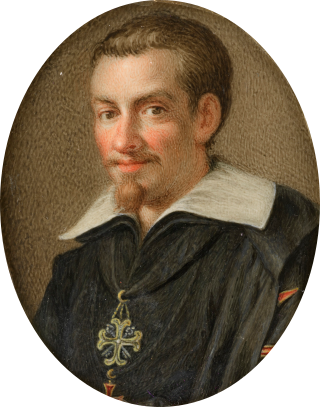
Francesco Vanni was an Italian painter, draughtsman, printmaker, publisher and printer active in Rome and his native city of Siena.

Cesare Nebbia (c.1536–c.1614) was an Italian Mannerist painter from Orvieto.

Antonio d'Enrico, called Tanzio da Varallo, or simply il Tanzio was an Italian painter of the late-Mannerist or early Baroque period.
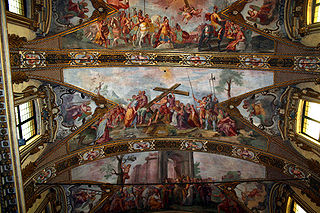
Giovanni Battista Carlone (1603–1684) was an Italian painter of the Baroque period, active mainly in Genoa.
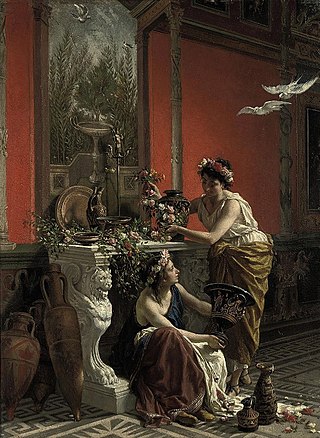
Cesare Mariani was an Italian painter and architect of the late-19th century, active in Rome and Ascoli Piceno.

Giuseppe Nicola Nasini was an Italian painter of the Baroque period and active in Rome and Tuscany.
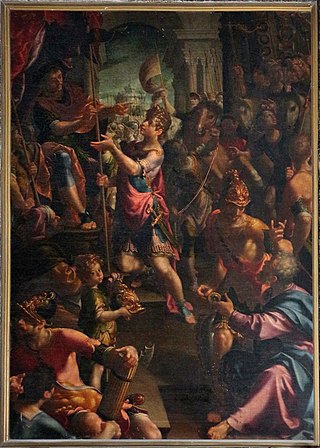
Aurelio Lomi was an Italian painter of the late-Renaissance and early-Baroque periods, active mainly in his native town of Pisa, Tuscany.

Lippo Memmi was an Italian painter from Siena. He was the foremost follower of Simone Martini, who was his brother-in-law.
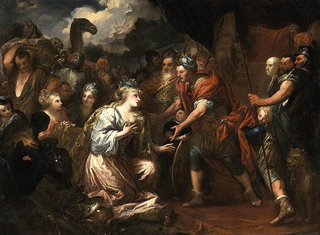
Pietro Dandini was an Italian painter of the Baroque period, active mainly in Florence.

Pompeo Ghitti was an Italian painter of the Baroque period, active mainly in and in towns surrounding Brescia.
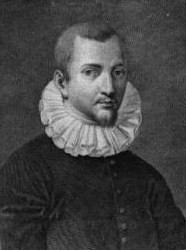
Rutilio di Lorenzo Manetti was an Italian painter of late-Mannerism or proto-Baroque, active mainly in Siena.

Jacopo di Mino del Pellicciaio was an Italian painter, active in Siena.

The church of Santi Severino e Sossio and the annexed monastery are located on via Bartolommeo Capasso in Naples, Italy.

Sebastiano Folli (1568–1621) was an Italian painter of the late Renaissance period. He was a scholar of Alessandro Casolano, and a native of Siena. He distinguished himself by several frescoes in the churches at Siena, particularly the cupola of Santa Marta, and some subjects from the Life of St. Sebastian, in the church of that saint, painted in competition with Rutilio Manetti, to whose pictures they are in no way inferior. He visited Rome, and was employed in some considerable works for the Cardinal de' Medici, afterwards Leo XI. He died in 1621.
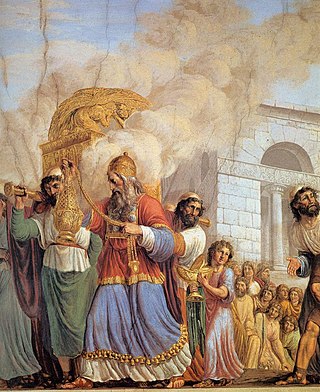
Luigi Ademollo was an Italian painter.

San Niccolò al Carmine, also called Santa Maria del Carmine is a Renaissance style, Roman Catholic church and monastery located in Pian dei Mantellini #30, near the corner of Via della Diana in the Terzo de Citta of Siena, region of Tuscany, Italy. The church now serves as the Oratory for the Contrada of Pantera. Across the street from the belltower is the Palazzo Celsi Pollini. North along Pian dei Mantellini, toward the Arco delle Due Porte, and on the same side of the street are a number of palaces built around what was once the Monastery of the Derelict Women: in order they are the Neoclassical Palazzo Incontri, the Palazzo Ravissa and the Palazzo Segardi.

Santa Caterina da Siena is a Baroque architecture, Roman Catholic church in the district Venezia Nuova central Livorno, region of Tuscany, Italy. It stands in front of the Piazza dei Domenicani. The church is notable for its tall octagonal dome and lantern rising above a rough, unfinished rectangular base.

Cenni di Francesco di ser Cenni was an Italian Gothic painter active in Florence between 1369/1370 and 1415. His only signed work is the fresco of the True Cross at the Cappella della Croce di Giorno at the church of San Francesco in Volterra, painted in 1410. A couple of dozen works have been attributed to Cenni di Francesco on the basis of a similarity of style with the fresco.

Giuseppe Maria Terreni was an Italian painter.